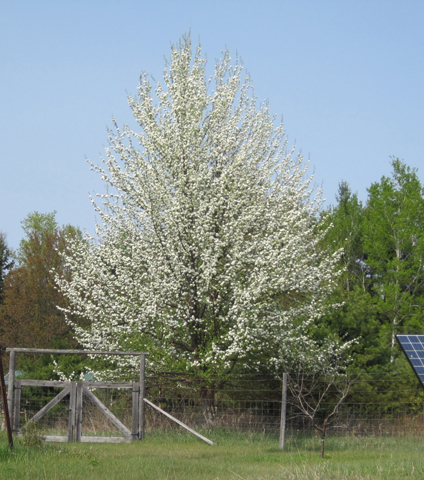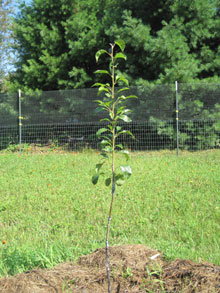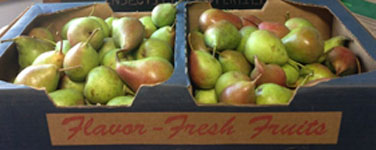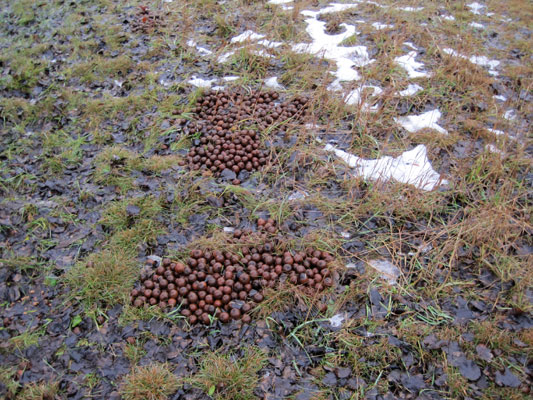|
| ||
|
Apples
Blueberries |
The ManyTracks Orchard Pears
Four decades of Growing
Good Food
in Michigan's Upper Peninsula |
Savignac VermontBeauty |
|
The very first planting on our new
homestead was some apple trees and a Bartlett pear, maybe something else.
Purchased from a nursery downstate it was what they recommended. We brought them north and planted them in the newly fenced (we
did know about deer) cold and wind-swept (except from the west)
garden-orchard area in 1978. We had no amendments to add to the old worn-out sod
soil, no mulch to help the new trees get established, little water to help them
thrive, no time to devote to the new orchard, and no knowledge of pruning. And
most of the varieties weren't the best choices for the cold north. Yet many of
the apple trees lived to set fruit. The Bartlett didn't make it past the first few winters. It
wasn't its fault; it was a poor choice, especially with so little initial care. 2024 -- Another interesting weather year. Last year we had 2 months drought May and June, then record heat. This year we had record rain May and June and 2 1/2 months drought mid-August through October! We fussed about it but the trees did just fine though maybe a bit stressed. No new fireblight except in chokepear, still have blister-mites in Sierra but not as bad as last year. Overall the trees look fine. The big fun this year was first fruit of L'Anse, Nova, Patten and Helmer! We enjoyed them all but now I'm wondering just what I'm going to do with all the fruit when they really start producing? With our warm root cellar at harvest time (September-October) they aren't going to keep long, and we are really into apple eating at this season. I'm sure I'll be getting into pear sauce and pear juice in the future. And be finding out which of our friends like pears! 2022 -- Relief from Fireblight -- Steve cut off the badly fireblighted top of Chokepear, and I pruned off a lot of old fireblighted wood but saw little sign of new strikes, just a few shoots. But no fireblight anywhere else. Sprayed early with Neem, later with fermented comfrey/spinach tea and overall the pears looked good (except for blister-mites in Sierra). Got the first, and only, Sierra fruit! Delicious. Also small harvest of Summercrisp (not delicious). Weather continues with warmer summer but overall it was more or less "normal", with all the variations that implies. 2021 -- Another Hot Year, and Dry -- I pruned all damaged/fireblighted wood I could off Stacey and Chokepear in April/May. Someone had suggested spraying with a dilute solution of raw vinegar in water. I sprayed again and again, Stacey and Chokepear and any apple that had a touch of FB last year. But it was soon apparent that Stacey was too far gone. Steve cut it down. Chokepear had a lot of FB but also a lot of good green leaves. Steve cut off the 2nd of its three trunks, leaving the best, smallest north trunk. There's hope. All young pears did well as did Summercrisp and its many, mostly Sierra, grafts. 2020 -- Fireblight -- This year I learned about fireblight, in a big and sad way... On a year with record heat and long summer fireblight showed up in a big way. Both Stacey and 40 yr old Chokepear, full grown and blooming, were hit hard. Surprisingly, nearby Summercrisp didn't have even a touch, nor did any of its grafts. Younger usseriensis root stock, also nearby, lost four grafts one by one. The only one to survive was a Nova. There were strikes on some apples, too, but only one loss (a young graft). Was it the weather? Did I introduce it to the orchard via the many scions we'd grafted? I'd only seen a touch of it previously, a few leaves here and there. I'll never know. I started pruning off strikes until I realized it was a losing operation. I finally just let it go and hoped for the best. It didn't look good. But all my young pears, ten, none of them of blossoming/fruiting age, did just fine, with no strikes. It was a good growing year for them.
2017 September - Pear Faith --
Last September we were at a polka dance in L’Anse and a young couple brought
in a wonderful basket of beautiful medium-small pears for the snack table.
My experience with pears had been pretty much limited to occasional canned ones
and a handful of first small Stacey & Summercrisp pears from our young
trees. Happy to have something other than sugar snacks, both Steve and I
picked up a pear and a few cherry tomatoes. When I sat down and took a bite of the pear...Wow! I had no idea pears could be that good.
Sweet, smooth, great texture, wonderful snack size. Immediately I went back to the table for
another one. Industrious Squirrels Help in the Orchard - November 25, 2018 -- Our large "chokepear" is beautiful in bloom and prolific in fruit. Unfortunately for us the fruit is small (pingpong ball size) and very astringent. We call it a chokepear but it is simply a common pear seedling that was used for rootstock for a Bartlett pear we planted almost 40 yrs ago. The tree died the first or second winter and the rootstock grew up from the roots to be a beautiful large tree. Up until a few years ago I didn't pay much attention to it except to admire it. It was outside the fence and the deer and squirrels and other creatures made good use of the fruit, always clearing up whatever there was, so I had never paid attention to the fruit either. When we re-fenced the expanded orchard last year the old pear ended up inside the fence - outside of the reach of the deer. And I became quite aware of how much fruit it put out, and dropped. I was sorry to have taken it away from the deer but picking up hundreds (thousands?) of little chokepears just wasn't in my schedule, or desire. I thought of raking up a few buckets for them this year but I don't mow under this tree so there was no way to rake them up from the tall vegetation. I would have liked to remove the the fruit not only for the deer but it helps for disease control to keep drops picked up. But they were left, scattered thickly under the tree and underfoot. Now the deer couldn't get at the fruit but a little thing like a fence certainly wasn't going to stop a squirrel. Especially with a wonderfully large brush pile just outside for shelter. It, or they (I've only seen one at a time), had a well packed runway from brush-pile to tree, and a well used favorite limb to eat on. It always had little round pears stashed against a spur or branch, and a large mound of munched pieces and partly eaten fruit below. It was obviously doing its best to eat as many as it could, and being quite vocal about any intrusion into its personal feed lot.
Copyright © Susan Robishaw |
||



 It
was an early cold this year and up until a few days ago we had about 8"
of snow - not a lot but enough to make it feel very much like winter
already. Then came two days of balmy above freezing 40 degree rain. That
melted almost all of our snow and I took advantage of the warm (these
things are relative) weather to do a few more chores out in the orchard.
I walked by the chokepear, snow gone and grass matted down, to find, to
my great surprise, five neat piles of chokepears. There were still some
scattered around but not many. The squirrel(s) had done quite a job! I
was very impressed. I would not be so impressed, of course, if these had
been good edible pears! But I did my duty, got out my shovel and scooped
up three bucket-loads, dumping them outside the fence for the deer, and
the squirrel. I wasn't nearly as neat in doing my part but I got the
job done. I don't know if the deer are going to get any but the
squirrel went right to work on the pile right outside its brushy door.
It
was an early cold this year and up until a few days ago we had about 8"
of snow - not a lot but enough to make it feel very much like winter
already. Then came two days of balmy above freezing 40 degree rain. That
melted almost all of our snow and I took advantage of the warm (these
things are relative) weather to do a few more chores out in the orchard.
I walked by the chokepear, snow gone and grass matted down, to find, to
my great surprise, five neat piles of chokepears. There were still some
scattered around but not many. The squirrel(s) had done quite a job! I
was very impressed. I would not be so impressed, of course, if these had
been good edible pears! But I did my duty, got out my shovel and scooped
up three bucket-loads, dumping them outside the fence for the deer, and
the squirrel. I wasn't nearly as neat in doing my part but I got the
job done. I don't know if the deer are going to get any but the
squirrel went right to work on the pile right outside its brushy door.